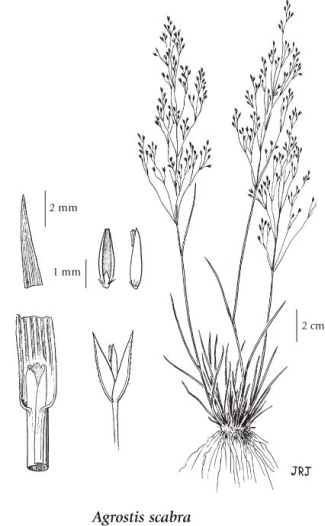Agrostis scabra Willd.
hair bentgrass (rough bentgrass; winter bentgrass)
Poaceae (Grass family)
Introduction to Vascular Plants
hair bentgrass (rough bentgrass; winter bentgrass)
Poaceae (Grass family)
Introduction to Vascular Plants
Species Information
General:
Perennial, densely tufted grass from fibrous roots; stems 20-75 cm tall.
Leaves:
Sheaths smooth, blades mostly basal, 4-14 cm long, 1-3 mm wide, flat, finely rough short-hairy; ligules 2-5 mm long.
Flowers:
Inflorescence broadly egg-shaped, open, large, upright, 10-30 cm long, about as wide as long, very diffuse with hairlike, lax branches 8-25 cm long, frequently detaching at maturity, the lower branches 4-11 cm long, broadly spreading at maturity, branched 1 or 2 times above the middle, the spikelets few, broadly separated at the tips of the branches, not near the base; glumes 1.5-3 mm long, rough short-hairy on the keels; lemmas 1.5-2 mm long, awnless or sometimes awned from below the middle on the back, the awns to 2 mm long, more or less straight, the callus hairs minute; paleas absent or if present, minute, less than 1/4 as long as the lemmas; anthers 0.4-0.7 mm long.
Notes:
Agrostis perennans (Walt.) Tuckerm., hitherto regarded as an eastern species, has recently been found in WA and can be expected in BC. It differs from A. scabra in its slightly more condensed but still hairlike inflorescence and few or no basal leaves at flowering time but several well-developed stem leaves. It grows on moist to wet cliffs and streamsides. See also comments under A. idahoensis.
Illustration

If more than one illustration is available for a species (e.g., separate illustrations were provided for two subspecies) then links to the separate images will be provided below. Note that individual subspecies or varietal illustrations are not always available.
Illustration Source: The Illustrated Flora of British Columbia
USDA Species Characteristics
Flower Colour:
Yellow
Blooming Period:
Early Spring
Fruit/Seed characteristics:
Colour: Brown
Present over the Summer
Source: The USDA
Ecology
Ecological Framework for Agrostis scabra
The table below shows the species-specific information calculated from
original data (BEC database) provided by the BC Ministry of Forests and Range.
(Updated August, 2013)
The table below shows the species-specific information calculated from
original data (BEC database) provided by the BC Ministry of Forests and Range.
(Updated August, 2013)
| Site Information |
Value / Class |
||
|
Avg |
Min |
Max |
|
| Elevation
(metres) |
1138 | 8 | 2400 |
| Slope
Gradient (%) |
14 | 0 | 230 |
|
Aspect (degrees) |
196 | 2 | 360 |
| Soil
Moisture Regime (SMR) [0 - very xeric; 4 - mesic; 8 - hydric] |
4 | 0 | 8 |
| Modal
Nutrient Regime
Class |
C | ||
| #
of field plots species was recorded in: |
660 | ||
| Modal
BEC Zone Class |
ESSF | ||
|
All BEC Zones (# of stations/zone) species was recorded in |
BG(5), BWBS(17), CDF(5), CMA(1), CWH(52), ESSF(123), ICH(77), IDF(67), MH(15), MS(104), PP(1), SBPS(41), SBS(116), SWB(2) | ||
|
Source:
Klinkenberg 2013
|
|||
Habitat and Range
Moist to dry meadows, rock outcrops, forest openings, clearings and roadsides in the lowland to subalpine zones; common throughout BC; amphiberingian, N to AK, YT and NT, E to NF, S to ME, MA, PA, NC, FL, MS, LA, TX, NM, AZ, MX and CA; Greenland, NE Asia.Status Information
Synonyms
Synonyms and Alternate Names:
Agrostis geminata Trin.
Agrostis hyemalis (Walter) Britton, Sterns & Poggenb.
Agrostis hyemalis var. geminata (Trin.) A.S. Hitchc.
Agrostis hyemalis var. scabra (Willd.) Blomquist
Agrostis hyemalis var. tenuis (Tuckerman) Gleason
Agrostis scabra subsp. septentrionalis (Fern.) A.& D. L÷ve
Agrostis scabra var. geminata (Trin.) Swallen
Agrostis scabra var. septentrionalis Fern.